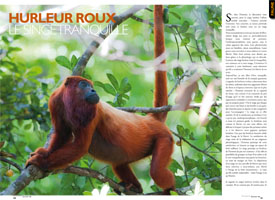Whilst man has not yet settled the question to his satisfaction, for the howler monkey it is clearly essence which precedes existence. The character and innermost nature of the red howler are as they are, and it is a placid monkey.
We like to think that we have a certain degree of free will and, particularly when dealing with primates, we easily fall prey to anthropomorphism beneath the apparent calm of our words. Their physiognomy is familiar and there is even a certain resemblance. Their gestures are reminiscent of ours and of our freedom. But their actions are dictated by their genes and resultant physiology. The essence of the red howler monkey being placidity, their existence corresponds to this quality. Evolution led its good-nature as surely as it condemned man to freedom of action.
Today I am free to be calm too, sitting on a branch in the canopy in French Guiana, watching howler monkeys tranquilly move about in the trees, imprisoned in their apparent freedom of choice and restricted spaces. Who is the happier? Man aware of his ability to exert a choice, but equally aware of what little use he often makes of this faculty, assailed by multiple oppressive forces and paralysed by his own fear? Or the monkey who finds fruits and leaves to his liking every day, branches to rest on, and fellow howlers for company? The monkey is satisfied. And from satisfaction and happiness there is only one step – albeit an anthropomorphic on – which we easily take if we are not careful. Happiness, like freedom, is a vast issue, and extremely difficult to apply to primates, even though observing them can shed some light on the matter. Part of human happiness resides in exerting freedom. Satisfaction for the monkey comes from meeting physiological demands. Man plays his part in this satisfaction by leaving enough forest to the monkey. The monkey takes part in human happiness via his existence, meaning we can climb to the top of a tree and calmly watch a monkey sitting in the branches eating a fruit. The disappearance of the monkey is a bit of freedom we deprive ourselves of, a freedom which, like the Amazonian forest, is so vast that it seems inexhaustible, but this is in fact an illusion.
I watched the howler monkeys moving around in the canopy. They do not run, they do not jump very much, they walk. As they move around it is as if they allowed themselves to go for a little outing between two naps. When they’ve had enough with the leaves of one tree they go to the next one. There is nothing urgent about it, the fruits are there waiting for them. They move together, often on the same branches. If they do need to jump, they patiently wait their turn in the same spot. The first one jumps to a tree and then pauses for a moment. The others follow unhurriedly, certain of the abundance of the forest. If it is easy to move around then they walk in the trees, and sometimes use their long tail to lower themselves down to another branch. I like howler monkeys for their serenity, however anthropomorphic that might be. The face of the males is like that of an old wise man. They are not shy and often come close, calmly looking at the man in the treetops. Not being automatically hated is always reassuring and relaxing. I am there and they pass by, eat, or sleep.
Of course, the monkeys sometimes howl. But there is nothing violent or fearful about their calls. They convey life. A troop of monkeys is there, living in the trees, and they are letting that be known. The calm of the forest does not arise from silence but on the contrary from the many different noises. The howling of the monkeys is echoed in the variety of answering calls which resemble, contrast with or modulate their cries. That is how the forest is. It is alive with many-decibeled serenity.
A bit of ecology
Who, on spending their first night in a hammock in the forest of French Guiana, has not been terrorised by this cry from beyond the grave? A hoarse, breathy cry that travels kilometres through the woods and makes your blood run cold when it is not yet daybreak. Is that an exaggeration? Hardly. However inoffensive the howler monkey might be it fully deserves its name. And its howling is one of the sounds that goes to make up the life of the Amazonian forest.
Like all New World monkeys, howler monkeys are platyrrhines*. They differ from their relatives in the rest of the world (catarrhines*) in that their nostrils are set far apart and are side-facing. In South America there are nine species of howler monkeys, making up the Atelidae family. Only one of them is found in the Guiana Shield region, the Venezuelan red howler monkey (Alouatta seniculus). But nowadays the scientific community agrees that the French Guianan subspecies (A. seniculus macconnelli) is a species in its own right, called the Guyanan red howler or Alouatta macconnelli.
The red howler can be easily distinguished from other monkeys in French Guiana by its red fur, removing any possible doubt when observing monkeys in the forest. Their size is also a good criterion since together with the red-faced spider monkey (Ateles paniscus) it is one of the largest monkeys in South America. A male weighs about 9kg and measures around 65cm. The prehensile tail is about 70cm long and used as a fifth limb, enabling the red howler to hang in the air. It is a very good “tool” for the animal as it makes it easier to get around and access food resources.
Whilst the greatest concentrations of red howler monkeys would appear to be in the upper forests, the species is also widely distributed across the secondary and even mangrove forests. Their capacity to adapt means they maintain their numbers in habitats which have been slightly disturbed and in fragmented sections of forest. They live in family groups made up of between four and six individuals. Normally there is one male and two adult females with their young. A female gives birth to one baby every two years after a six-month gestation period.
A monkey which saves its energy
The groups are largely inactive. Three-quarters of the day are spent resting and sleeping. The remaining quarter is spent looking for food, but taking care not to move around too much. They cover less than 800 metres per day. And it is the red howler’s diet that explains its apparent “laziness”. The animal eats mainly leaves and this, as everyone will surely agree, does not represent the same energy intake as a good sweet, ripe fruit. However, during the fruiting months, the howler monkeys are a bit more active and if the opportunity presents itself, quite happily eat fruit, seeds, and buds.
The characteristic howls of howler monkeys are a good way for the species to save its energy, as the cries made by the group in chorus serve primarily to indicate their presence far off and thus to avoid conflict with other groups of red howlers.
Their impressive howls result from a modification to the hyoid bone in the throat, which is unusually developed and acts as a resonating chamber.
Howler monkeys are disseminators of seeds and play an important role in the structure and regeneration of the forest. Other monkeys disseminate seeds more or less homogenously over large areas, such as spider monkeys and capuchin monkeys (Cebus sp.) which are highly mobile and have rapid intestinal transit, but this is not the case with howler monkeys. They do not move around much, digest slowly, and often sleep in the same places. There is therefore a concentration of seeds in their dung on the ground. This results in local alterations to plant populations, with a large number of species of plants whose fruits and seeds they consume to be found beneath their dormitories.
The danger comes from above
In their apparently tranquil existence up in the trees, red howlers do however have some predators that come and disturb them. There is a particular bird that these primates fear like the devil, the harpy eagle (Harpia harpyja). It is one of the largest birds of prey in the world and is known to attack sloths and primates, including howler monkeys. Observers who have seen them catch prey refer to the violence and suddenness of the attack, causing major trauma in the group judging by the intensity and duration of the distress cries after such an event. Howler monkeys also appear to fear certain constructors such as boas, who can no doubt swallow young primates.
To a lesser extent certain arboreal felines such as the margay (Felis wiedii) occasionally attack small species of primates and young howler or spider monkeys. Cases of predation of howler monkeys by jaguars (Panthera onca) are also known. Scientists in Venezuela have observed a jaguar eliminate five out of the six individuals in a group of howler monkeys over a period of seven months. Only the youngest one survived.
What status for the howler monkey?
Monkeys are hard hit by human pressure arising from the exploitation of forest resources and development needs. Certain species surviving on vast forest territories cannot maintain their numbers in disturbed habitats. Their slow reproductive cycle with a six-month gestation period, slow growth, and sexual maturity at the age of five for red howler monkeys, means the animals resist poorly to direct pressures such as hunting. But monkeys are an important source of protein for communities living off the forest. Overhunting due to the demographic explosion in their living zones and the sale of game on the black market are slowly but surely resulting in the decline of certain species. This is the case for example of the red-faced spider monkey, which has now disappeared from entire parts of French Guiana. In some areas howler monkey populations are also declining. The absence of any hunting quotas and more generally of any hunting regulation in French Guiana means that there are frequent abuses everywhere around the country. But red howler monkeys have a far superior capacity to adapt than spider monkeys. Their ecological requirements are less restrictive (a reduced home range and more flexible diet), meaning the species can survive in fragmented islands of forest. This is the case right next to the Ile de Cayenne (on the Vidal footpath for instance), where it is still possible to hear this fabulous howl, as if to remind the town of its limits.




 English
English Français
Français  Português
Português 












 Télécharger l'article en PDF est réservé aux abonnés Web !
Télécharger l'article en PDF est réservé aux abonnés Web ! 
 1 votes.
1 votes. Pas de réaction
Pas de réaction Comment!
Comment!


 Voyages avec Tooy. Histoire, mémoire, imaginaire des Amériques noires : Editions Vents d’ailleurs, 2010
Voyages avec Tooy. Histoire, mémoire, imaginaire des Amériques noires : Editions Vents d’ailleurs, 2010
 Guyane. Produits du terroir et recettes traditionnelles. L’inventaire du patrimoine culinaire de la France : Editions Albin Michel, 1999
Guyane. Produits du terroir et recettes traditionnelles. L’inventaire du patrimoine culinaire de la France : Editions Albin Michel, 1999
 Alunawalé, un voyage à travers les milieux naturels de Guyane : Office National des Forêts, 2009
Alunawalé, un voyage à travers les milieux naturels de Guyane : Office National des Forêts, 2009
 Augusta Curiel, Fotografe in Suiriname 1904 – 1937 : Libri Misei Surinamensis, 2007
Augusta Curiel, Fotografe in Suiriname 1904 – 1937 : Libri Misei Surinamensis, 2007


